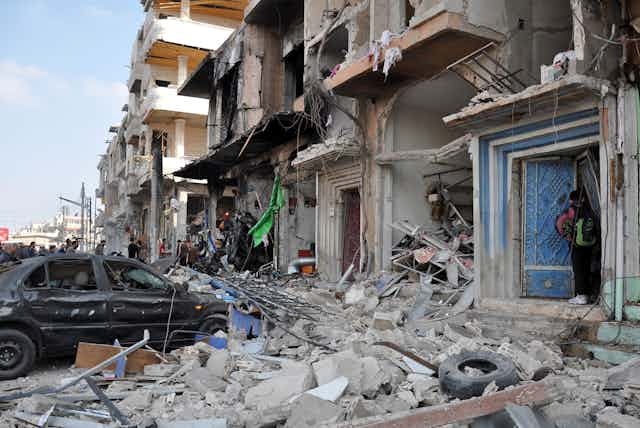Syrian peace talks are due to resume in Geneva on March 9, reflecting a sign of growing confidence in the ceasefire that began on February 27. The Geneva talks are meant to finally start acting on UN Security Council Resolution 2254, which calls for a resolution of the crisis – yet even with the ceasefire in place, the journey ahead is looking increasingly precarious.
Building the requisite trust on all sides is vital if the diplomatic process is going to work. But since the ceasefire, plenty of allegations have been made that the other side had breached the ceasefire – and conditions on the ground remain tense.
Hundreds of thoudsands of Syrians are trapped in besieged towns, and millions more are in areas that are difficult to reach. And the violence is not over: the “ceasefire” does allow for continued military action against those groups the UN designates as terrorists, notably Islamic State (IS) and Jabhat al-Nusra.
Of course, the Assad government’s attempt to frame all opposition groups as terror groups has made a diplomatic solution fiendishly elusive, and has hamstrung the effort to build trust between the parties involved.
From this, a number of rebel groups have greeted the ceasefire with scepticism amid allegations of a lack of consultation.
Despite the ceasefire agreement, uncertainty and distrust haunt the diplomatic process, as a consequence of the range of actors and the deep seated grievances involved. External actors have been shaping events in Syria since the onset of the civil war, deepening schisms within the state and facilitating its fragmentation.
The Assad regime has twice emerged like a phoenix from the embers of the conflict because of external support – propped up by Iran in 2012 and Russia since 2014. But this time is different. As the next round of talks approach, and as Russia continues its air strikes on his behalf, Assad is in a much stronger position.
Tense neighbourhood

In an interview with El Pais, Assad restated his desire to save Syria from the conflict and further collapse. Assad also strongly condemned Turkey, emphasising the need to prevent “other countries, especially Turkey, from sending more recruits, more terrorists, more armaments, or any kind of logistical support to those terrorists”.
Of course, this issue is complicated by Ankara’s increasingly violent relationship with the Kurds who, in recent days, have begun to work closely with Assad in the fight against IS.
To the south, Saudi Arabia is conducting Operation Northern Thunder, the largest military drill in the region’s history, which is designed to deter Iran from interfering in the domestic affairs of Gulf states. The Saudi foreign minister, Adel al-Jubeir, has openly called for regime change and has offered to provide anti-aircraft weapons to rebel groups, which will pose a serious threat to Syrian and Russian aircraft.
Such concerns will only undermine the trust-building efforts that could determine whether the ceasefire holds. Concerns about a breakdown of the ceasefire has led to calls for the creation of a plan B.
By way of coming up with one, US secretary of state John Kerry has floated the idea that Syria be partitioned – much as now vice-president Joe Biden once suggested partitioning Iraq along sectarian lines. But what would a partitioned Syria look like, and who would be in charge of the partitioning, remains unclear.
Tangled problems
The UN’s Independent International Commission of Inquiry on Syria has also noted that Syria is on the brink of collapse, and that war crimes conducted by a range of actors are “widespread and rampant”. The Syrian people’s suffering goes on, with around 400,000 killed and 11m displaced. Both physical and mental health are under ever-increasing pressure, and aren’t helped by environmental crises, which include severely reduced access to water.

Some assistance has gotten in: the UN recently reported that 21 tonnes of aid have finally reached the besieged city of Deir ez Zor. But half the aid airdropped there is now apparently unaccounted for, and a number of other requests for aid are still awaiting approval from Damascus.
Ultimately, the problems and enmities at the heart of the Syrian conflict are inextricably interwoven. Remember that in 2013, the British parliament voted not to bomb regime targets across Syria, yet in December 2015 voted to strike against IS targets in the state. That’s a somewhat artificial distinction: many who join or follow IS, in whatever way, cite the brutality of the Assad regime as their prime reason for doing so. A number of prominent officials from Gulf states have stressed the culpability of Shia organisations in the violence across the region.
To defeat IS, the brutality of the Assad regime must end – yet to defeat Assad, Sunnis across Syria and Iraq must be empowered so they are not forced to turn to IS to meet their basic needs. With all this uncertainty, a meaningful ceasefire feels a long way away.
This piece has been updated to reflect developments in the ceasefire.

